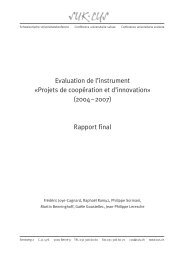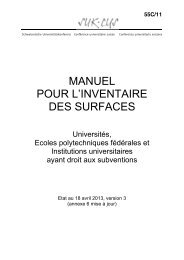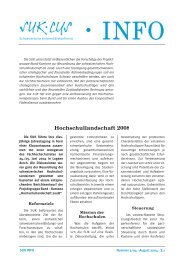Evaluation of the Swiss Virtual Campus - Schweizerische ...
Evaluation of the Swiss Virtual Campus - Schweizerische ...
Evaluation of the Swiss Virtual Campus - Schweizerische ...
You also want an ePaper? Increase the reach of your titles
YUMPU automatically turns print PDFs into web optimized ePapers that Google loves.
SVC Final <strong>Evaluation</strong>. Background Report Lepori and Probst<br />
not seem to have an impact on <strong>the</strong> evaluation <strong>of</strong> collaboration. Our supposition is that projects<br />
from <strong>the</strong> impulse phase have automatically reduced real collaboration to a few partners, and<br />
thus are, in this respect, more similar to <strong>the</strong> consolidation phase projects.<br />
Regarding learning management systems, <strong>the</strong> national content server is not used by many<br />
projects. During <strong>the</strong> monitoring visits, several times a certain degree <strong>of</strong> discontent emerged<br />
regarding <strong>the</strong> lack <strong>of</strong> a clear policy – projects state that <strong>the</strong>y never knew about <strong>the</strong> future <strong>of</strong> <strong>the</strong><br />
national content server, and some also expressed <strong>the</strong>ir disappointment regarding <strong>the</strong> fact that<br />
<strong>the</strong>y are now suddenly required to pay fees for every student using this LMS. Overall, most<br />
projects use <strong>the</strong> LMS provided by <strong>the</strong>ir CCSP or an open source system.<br />
Overall, <strong>the</strong> projects <strong>the</strong>mselves evaluate <strong>the</strong>ir future sustainability ra<strong>the</strong>r positively. The<br />
monitoring visits, however, gave <strong>the</strong> impression <strong>of</strong> very different types <strong>of</strong> projects regarding <strong>the</strong>ir<br />
commitment and proactivity. Some projects already have clear ideas about how <strong>the</strong> future<br />
needs will be covered – for example by selling <strong>the</strong> course in continuous education, by<br />
employing assistants who, instead <strong>of</strong> o<strong>the</strong>r tasks, are responsible for maintenance and updating<br />
– or see it as part <strong>of</strong> <strong>the</strong>ir day to day work to continue to update and develop <strong>the</strong> projects (as<br />
<strong>the</strong>y would do for traditional teaching as well), while o<strong>the</strong>r projects have less definite<br />
perspectives: <strong>the</strong>y underline that <strong>the</strong>y think it is a pity that SVC does not continue, that <strong>the</strong>y will<br />
not have <strong>the</strong> resources for updating and development, that <strong>the</strong>ir project probably will get lost.<br />
Thus, it seems that some projects have become a really integrated part <strong>of</strong> <strong>the</strong> pr<strong>of</strong>essors’<br />
teaching portfolio, while at <strong>the</strong> o<strong>the</strong>r extreme <strong>the</strong>re are cases ra<strong>the</strong>r like independent projects<br />
that will be concluded at a certain moment in time and not integrated in <strong>the</strong> normal, day-to-day<br />
teaching/working/research process.<br />
These results show that fears that most SVC projects will stop with <strong>the</strong> end <strong>of</strong> federal funding<br />
are not justified; but it is also not possible to say much about how effective was <strong>the</strong> use <strong>of</strong><br />
money and if <strong>the</strong> relationship between funding volume and output has been correct. The opinion<br />
<strong>of</strong> most people interviewed in <strong>the</strong> rectorates and in CCSP was that especially <strong>the</strong> 1 st and 2 nd<br />
series projects were too strongly focused on high-level products and complex technology; <strong>the</strong>se<br />
projects seem to have found <strong>the</strong>ir way to a use in face-to-face teaching, but most respondents<br />
agreed that <strong>the</strong>re was little relationship between <strong>the</strong> uses and <strong>the</strong>ir funding volume. In this<br />
respect, <strong>the</strong> decision <strong>of</strong> going towards smaller projects in <strong>the</strong> Consolidation Programme is seen<br />
by most people as very correct. In fact, some HEIs stated that <strong>the</strong>y went a step fur<strong>the</strong>r in this<br />
direction, by funding even smaller projects and giving seed money to pr<strong>of</strong>essors for some<br />
innovative activities.<br />
46










